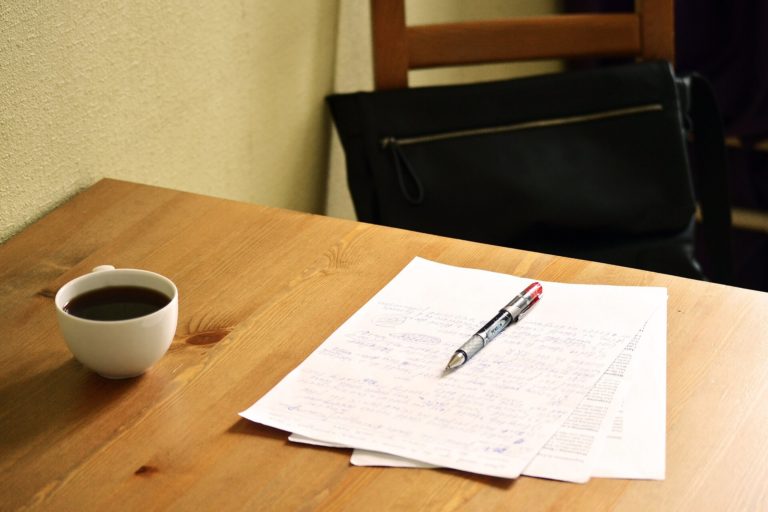Blog:
In other words
My 6-step translation process
A prospective client recently approached me about a translation project that required a fast turnaround. I turned down the job offer because I didn’t think I could provide a satisfactory translation within the client’s envisioned timeframe.
That prompted the question: Why does a professional translation take longer than many people expect?
People often don’t know how involved the translation process is when they start to look for a professional translator. If you want a high-quality translation that is accurate, elegant, and error-free, you will want to hire someone who is willing to put in the time and effort.
The goal of a professional translator is to create a beautifully crafted text that retains the meaning of the original, has the appropriate vocabulary for the target audience, and sounds authentic. Ideally, the translation will be even better than the original.
How do we achieve that?
I told the prospective client that I go through a 6-step translation process for all my translation projects. Here they are in a nutshell:
Step 1: Reviewing the source text (project brief and research)
Step 2: Creating a draft translation (1st pass)
Step 3: Checking it for accuracy (2nd pass)
Step 4: Editing it for style and authenticity (3rd pass)
Step 5: Proofreading the final version (4th pass)
Step 6: Clarifying any questions with the client after the final document handover (project completion).
Step 1: Reviewing the source text
On receiving the original document (also known as the source text), I skim‑read it to get a feel for the content, particularly the subject matter, length, style, and technicality.
Why is this step important? Why don’t I start translating right away?
Because I need to get inside the author’s head and understand the message they are trying to get across. This ensures that I create a translation that retains the (intended) meaning of the source text.
I can also get a feel for the author’s voice and will try to mimic it in the next steps of my translation process. Having an idea about the author’s intention and vocabulary guides my selection of the appropriate word choice in the draft translation.
I also take note of any key concepts or terminology that I may need to research and decide whether any preliminary background reading of the subject is needed.

If necessary, I contact the client to address any open questions I have about the text. Before I begin the translation, I want to be sure that I have a clear understanding of what the author needs and wants.
Once the path ahead is clear, I will dive right in.
Step 2: Creating a draft translation
I begin to carefully work my way through the text and translate one sentence, phrase, or segment at a time.
That said, I do not create a word-for-word translation because that would make the final document (also known as the target text) sound unnatural and, well, translated.
As I mentioned in the introduction, my goal is to craft a translation that sounds authentic and is better than the original. To achieve this, I must ensure that I catch all the details, whether they are stated explicitly or read between the lines.
This is where my initial review of the text and the client brief (Step 1) comes in handy because I already have a feel for the author’s voice and understand their overall intent.
I will work my way through the source text until I reach the end. I don’t focus yet on the details of spelling and punctuation, although my internal editor and proofreader will be very tempted to smooth them out! But those steps come later on, and for a good reason:
Translating requires skills other than editing or proofreading, so I don’t do everything at the same time. This ensures that my mind is 100% on the current task of drafting the translation.
Step 3: Checking the draft for accuracy
Once I have completed my draft translation, I remain in “translator mode” for one more pass: I review my translation very carefully and compare it with the source text, sentence by sentence, with both texts next to each other on my screen.
I call this step the translation edit. A translation edit essentially ensures that the draft translation is an accurate representation of the original. It is the last time I refer to the source material, so this is my final chance to catch any word or phrase I might have missed or misinterpreted.
Some translators skip this step and go straight to the editing or proofreading stage, but that is extremely risky. Words or details can be easily missed when creating a draft translation because the mind is focused on typing the target text onto the screen while also considering the next words in the source text.
The translation edit ensures that the target text is accurate and complete.
The brain can only handle a limited number of tasks simultaneously, so it should not be forced to pay attention to more than one at a time.

The translation edit involves reading both the source and target texts while making the occasional amendment. I can focus all my attention on the content after I have created it, so my mind is no longer devoted to putting words on the screen.
A professional translator takes the time to check their work for accuracy, so make sure you hire someone who doesn’t skip this step.
Following the accuracy check/translation edit, I take a break (somewhere between a few hours to an entire day or more) before returning to the target text with a fresh mind.
The purpose is to have a mental break from the source material because the next steps require that I examine the translation based on its own merits, without the original text still on my mind.
Step 4: Editing the target text
When I return to the text alert and fresh, the next phase involves honing the translation without referring to the source material.
My focus is entirely on the wording, quality of expression, and sentence structure of the translation and on making the overall text sound natural and elegant.
I will improve the writing quality and flow and make amendments as needed, but I also take care not to change the meaning. There should not be anything in the translation that wasn’t in the source text.
The aim is to make the target text sound original and authentic, i.e., not translated. If the translator worked carefully and meticulously during the draft process (Step 2) and accuracy check (Step 3), this step should not take too much time.
This editing step is essential because it puts the finishing touches on the wording and can make the difference between an average translation and a great translation.
If there is enough time, I will take another break from the text to make the final proofreading stage more effective.
Step 5: Final proofread
The translation is accurate, complete, and elegant. But it’s not quite ready to be sent to the client yet.
This is the step where I put on my proofreader hat and go over the text with a fine-tooth comb, letter by letter and word by word.
Now the goal is to make sure every comma and semicolon are where they should be, no typos have crept in during the multiple passes over the document, and the writing is clean and consistent throughout.

Many translators will combine Steps 4 (edit) and 5 (proofreading), but I prefer tackling them separately because they require different skill sets. I also like to set the translation aside between the edit and final proofread to make sure that I am not “too close” to the text and can approach it with a fresh set of eyes.
Once I have proofread the final translation, I am confident that it is ready for the client.
Step 6: Returning the text to the client and answering follow-up questions
I send the proofread translation to my client and point out areas that require their attention before the final publication.
Many translators do not consider this step part of their translation process, but I specifically set time aside for the follow-up. It allows the client to review the document and get back to me with follow-up questions before their final deadline.
Why? Because it is possible that during the translation process, I have come across a phrase or a segment in the source text that wasn’t quite clear. I want to ensure that I didn’t inadvertently change the author’s intended meaning, so I will leave a comment in that section asking the client to verify it.
I contact the client immediately if there is enough time during the translation process itself, but sometimes the turnover needs to happen fast, so I don’t always have time to wait for the client’s response.
Also, more questions may crop up as I continue to work on the translation, so rather than sending multiple emails during the project, I prefer to email the client once at the end with all my queries. I also believe most people do not like to be inundated with messages!
Here are the six steps of my translation process again in a handy overview:
TAKE-HOME MESSAGE
- Step 1: I review all source documentation, check the client’s requirements, and get a general feel for the text.
- Step 2: I create a draft translation by meticulously going through the source text and crafting an accurate and complete translation.
- Step 3: I review the translation by carefully comparing it with the source text and making sure that no word or meaning was missed or misunderstood.
- Step 4: I set the source text aside and edit only the translated document to ensure that the wording is elegant and doesn’t sound “translated”.
- Step 5: I proofread the final version to ensure no typos or other errors have crept in.
- Step 6: I hand over the translation to the client and answer any follow-up questions.
There you have it: a detailed overview of my 6-step translation process.
I hope this article has given you a better understanding of why a translation shouldn’t be rushed, especially if you want it to be fit for purpose and error-free.
Let me know if you have a translation project in English or German in mind that I can assist you with.
Or perhaps you have completed Steps 1 and 2 already and now need a professional to check your draft translation (in English or German)?
My translation editing service will tackle Steps 3–6 for you, preparing your translated text so that it’s ready to publish and be shared with the world.

Christina Stinn is a professional translator, proofreader, and editor with a background in ecological research and experience in publishing peer-reviewed articles in academic journals. She is a Professional Member of the Chartered Institute of Editing and Proofreading (CIEP) and has a M.Sc. degree in International Nature Conservation. So far her work has included fiction and non-fiction books, academic journal articles, and marketing materials in English and German. She loves working with clients who strive to bring their writing to the next level and enjoys taking part in their journey. Find out more
YOU MIGHT ALSO LIKE:



